They’ll help you navigate challenges, build relationships, and create a unique brand. Think of them like the essential ingredients in your baking pantry: they’re necessary for ensuring a perfect outcome.
Ready to discover these secret ingredients for success? Keep on reading to find out more!
Editor’s Note: This was originally published back in 2018. It has been updated today, June 17, 2024.
What are business virtues?
In the context of any business, virtues refer to the positive character traits, values, and ethical principles that guide decision-making and actions within a company. These virtues play a crucial role in running a successful food business.
Businesses that uphold strong virtues are more likely to earn trust, build lasting relationships, and achieve long-term success. Having these virtues fosters a positive company culture and attracts and as well as retains customers, leading to increased profitability and sustainable growth.
For example, imagine a home baker known for their delicious cupcakes. They consistently use fresh, high-quality ingredients, demonstrating integrity and a commitment to quality, plus they note dietary restrictions, showing respect for their customers. The baker also donates leftover cupcakes to a local shelter, demonstrating social responsibility.
These virtues, woven into every aspect of their business, cultivate a loyal customer base and contribute to their overall success.
The Eight Business Virtues For Your Food
Now, let’s delve deeper into eight specific virtues that are essential for achieving success in the food industry.
Integrity
Integrity is the foundation of a successful food business. It means being honest and truthful in everything you do, even when no one’s watching. In the food industry, trust and safety are super important, so integrity is a must.
How do you know if your business has integrity? Look for these signs:
- Customer trust: People believe in you and your food.
- Customer loyalty: They keep coming back for more and tell their friends.
- Long-term success: Your business keeps growing and doing well over time.
Think of integrity as a secret ingredient that makes your business delicious in more ways than one!
Accountability
Accountability means taking responsibility for your actions and decisions. In the food industry, this means owning up to mistakes and quickly correcting them. Like integrity, this virtue is essential for building customer trust, fostering a positive work environment, and ensuring compliance with food safety regulations.
Here’s how accountability benefits your food venture:
- Builds customer trust: Customers appreciate honesty and knowing you’ll fix any problems.
- Fosters teamwork: If you have employees, being accountable sets a good example for them to follow.
- Ensures compliance: You follow food safety rules to keep your customers safe and avoid legal trouble.
Transparency
Transparency is crucial for food businesses, as it involves being open and honest with customers about ingredients, processes, and practices. This leads to building trust in your brand and allows customers to buy from you, knowing that your products align with their preferences and values.
For example, if you have an online cookie business, you should list all ingredients to ensure food safety, provide accurate nutritional information, and help customers make informed choices.
Transparency leads to:
- Customer confidence: People feel good about what they’re buying.
- Better issue management: You can quickly address any problems.
- Competitive advantage: Your honesty sets you apart. Additionally, if you publicize that you’re using high-quality ingredients, you can attract customers seeking premium products!
Fairness
Fairness is a core value for any successful business. It involves treating everyone equally and with respect, whether they are customers, employees, or suppliers. This means charging fair prices, paying employees a just wage, and ensuring timely payments to suppliers.
For example, suggested retail prices (SRPs) help maintain consistent pricing across different stores, ensuring customers are treated fairly regardless of where they shop.
Fairness in your business practices leads to:
- Customer trust: Customers feel valued when they know they’re being charged fairly and treated equally.
- Better employee morale: Fair treatment and compensation boosts employee morale and loyalty, leading to a more productive team.
- Strong supplier relationships: Paying your suppliers on time and offering fair terms cultivates positive relationships, ensuring a reliable supply of quality ingredients.
Resilience
Resilience is essential in the ever-changing food industry. Challenges are inevitable, from unexpected ingredient shortages to shifting consumer trends.
A real-life example of resilience is how the restaurant industry adapted during the COVID-19 pandemic. Since dining in was not possible, they innovated with takeout and delivery services, outdoor dining, and virtual cooking classes.
How can resilience benefit your food business?
- Grace under pressure: When faced with setbacks, you find solutions and keep moving forward.
- Adaptability: No matter the food trends that come up or what preferences customers suddenly have, you can embrace change and adjust your strategies to stay competitive.
- Positive mindset: You maintain optimism and motivate your team, even during tough times.
Innovation
Innovation is the key to keeping your food business fresh and exciting. It means thinking of new ideas for your dishes, services, or marketing strategies to attract and retain customers.
For example, if you want to start a Filipino restaurant, you could develop a unique fusion menu blending traditional flavors with international cuisine or offer innovative online ordering options to enhance convenience.
How innovation drives success:
- Competitiveness: Unique dishes and approaches set you apart from the competition.
- Happy customers: New and improved offerings keep customers engaged and coming back for more.
- Business growth: Expanding your menu or services to cater to emerging trends can attract new customer segments and boost your bottom line. For instance, making keto desserts in response to customer demand could attract a new group of customers!
Remember, innovation is not just about being different; it’s about creating value for your customers and staying ahead of the curve.
Customer-centricity
Customer-centricity means putting your customers at the heart of your business. This approach prioritizes their needs and preferences, ensuring their satisfaction and loyalty.
For example, a successful Mediterranean restaurant might prioritize customer feedback to improve its menu, ensuring that dishes are consistently fresh and delicious.
Customer-centricity drives success through:
- Customer satisfaction: Prioritizing customer needs and preferences leads to happy customers, who are more likely to return and recommend your business to others.
- Customer loyalty: When customers feel heard and valued, they become loyal patrons, choosing your establishment over competitors.
- Valuable feedback: Actively seeking and responding to feedback, both positive and negative, allows you to continuously improve and meet evolving customer expectations.
Social Responsibility
Social responsibility means caring about your community and the environment, not just profits. It’s about giving back and making a positive impact. For instance, you can use sustainable ingredients, minimize waste, and support local farmers by buying from them instead of the groceries.
How social responsibility benefits your business:
- Community support: Giving back to the community through donations or sponsorships fosters goodwill and attracts customers who value social impact.
- Environmental impact: Reducing your environmental footprint through sustainable practices appeals to eco-conscious consumers and can enhance your brand reputation.
- Customer trust: As mentioned above, customers are more likely to trust and support businesses that align with their values, such as environmental consciousness and community engagement.
By prioritizing social responsibility, you contribute to a better world and build a loyal customer base that values your commitment to something greater than just profits.
Now, here’s something else you need to know: while having these business virtues is important for running a successful food business, they’re not the only ingredients for success. You also need practical knowledge and skills to navigate the unique challenges of the food industry. But hey, you don’t have to look far to learn how to grow a successful business.
The answer is right here inside The Bailiwick Academy.
Join The Bailiwick Academy’s Food Business Bootcamp!
The TBA Food Business Bootcamp is a 14-week program that will give you the correct foundation to build and sustain a food business.
Here’s a sneak peek of what you’ll get inside the boot camp:
- Entrepreneurial Mindset: Spot untapped opportunities and stay ahead of food industry trends.
- Soul Branding: Identify your superpowers and attributes that set you apart to form an unforgettable brand identity.
- Branding 101: Develop a distinctive brand voice and an attention-grabbing visual identity.
- Business Basics: Avoid pitfalls that make 90% of new food businesses fail within the first year.
- Menu Planning: Master crafting irresistible menu items that keep customers coming back.
- Human Resources: Develop employee contracts, handbooks, and policies that protect your business.
- Marketing and Sales: Ignite buzz by creating irresistible social media campaigns that compel customers to share your brand.
- Accounting: Learn proven food costing techniques to price your menu items for optimal profitability.
- Food Costing: Discover inventory management hacks that lower costs and wastes, and give you high profit margins.
- Legal Fundamentals: Safeguard your food business from legal catastrophes by discovering the permits, licenses, and registrations you cannot overlook.
- Employment Law: Draft contracts that attract top talent, incentivize peak performance, and shield your business from legal backlash.
- Business Planning: Mesmerize investors, lenders, and partners with a business plan presentation that has them begging to fund your food empire.
This program is a comprehensive guide to building a low-risk, low-maintenance, high-profit food business. If you’ve been dreaming of turning your passion for food into a thriving business, this boot camp might just be the thing to help you get truly started!
Click here to secure your slot, and finally make your food venture dreams a reality!
—
Keep coming back to The Bailiwick Academy blog for more kitchen tips, tricks, and much more!
]]>Keep on reading. I’m going to talk about three things you can do to win in business—ones that The Bailiwick Academy can help you with!
How to Succeed in Your Business in 2024: Increasing Brand Visibility By Partnering With Others
Let’s face reality: nowadays, your target market’s attention span is getting shorter these days. That’s because of bombardment from different brands via social media posts and videos. Getting them to consider you instead of your competition is getting to be difficult.
Here’s a powerful strategy to cut through the noise: increasing your brand’s visibility through strategic partnerships. Why and how?
- Boosted Recognition: Partnering with others can place your brand in new and broader contexts, making it easier for customers to recognize and remember you. This visibility is crucial for fostering trust and loyalty.
- Competitive Edge: When your brand is seen alongside respected partners, it elevates your status and sets you apart from competitors. Customers are more likely to choose you when they see your brand frequently and in good company.
- Enhanced Brand Value: Collaborations not only increase recognition but also build brand equity. As your brand becomes more familiar and trusted through these partnerships, its overall market value and sustainability grow.
These three reasons are more than enough, don’t you agree? And if you’re looking for a brand to partner with, especially if your brand is related to the culinary arts, there’s no better choice than us at The Bailiwick Academy.
Why Partnering With The Bailiwick Academy Is A Good Choice
Our roster of instructors here at The Bailiwick Academy is composed of some of the best cooking and baking instructors here in the Philippines. With them, we have created life-changing and on-demand classes that have changed the lives of many Filipinas for the better—check out these success stories. That’s because our classes have given them the confidence to turn their passion for creating delicious food into profit.
Our culinary platform is not just about food, it’s about a lifestyle centered around creativity, passion, and enjoyment.
You can be part of this vision and help us create life-changing moments with our students.
And when you’ve partnered with us, your products are shown and used by our top-rated chefs and instructors. What kind of message do you think it’s sending?
- You’re a high-quality brand endorsed by our instructors.
- You’re trustworthy.
- “I remember you; that’s why I’ll buy your products.”
In addition to that, you’ll also get these exclusive deals:
- Boosted Visibility: Expose your brand to our audience and foster brand recognition and purchase.
- Engagement Opportunities: Actively engage with our audience and promote stronger connection and brand recall.
- Authentic Storytelling: Become an essential part of our student’s lives. Cultivate trust and loyalty among them and turn them into your brand advocates.
- Content Integration: Your products will be seamlessly fused into our face-to-face and online baking & cooking classes.
- Gifting and Rewards Programs: Position your brand as a thoughtful and rewarding choice.
We’re already trusted by brands like Penco and Buji.ph. Joining forces with us opens the door to a community of success, where your brand can shine brighter and reach further. Let’s create a future where our collaboration is your next big win.
Reach out to us at [email protected] to get started.
How to Succeed in Your Business in 2024: Make Employees Happy
The fast-paced nature of corporate life coupled with tight deadlines and high expectations can create a stressful environment. This can lead to significant effects on your business such as decreased productivity, a rise in absenteeism, high turnover rates, poor morale, and poor customer relationships.
But if you really want your business to succeed, you should help your employees manage stress and improve business productivity. After all, employees are the backbone of any business.
We can help you with that, with our baking and cooking classes!
Why Baking And Cooking Classes
You might be wondering why you should consider cooking and baking classes to help your employees. Well, they’re actually already proven to enhance efficiency and alleviate stress.
These classes are creative and therapeutic in nature, fostering mindfulness and a sense of achievement.
Additionally, you’ll get these benefits:
- A Closer Team: Participating in cooking or baking classes as a team fosters collaboration and teamwork. Employees learn to communicate, delegate tasks, and work together towards a common goal, which can strengthen interpersonal relationships in the workplace.
- More Creative and Innovative Workers: Cooking is an art, and baking often involves precise measurements. Both activities encourage creativity and innovation, skills that can be transferred to problem-solving and ideation in the workplace.
- Time Management Skills: Many recipes have specific timelines, requiring participants to manage their time effectively. This skill is transferable to the workplace, helping employees prioritize tasks and meet deadlines efficiently.
- Work-Life Balance: Cooking and baking classes provide a balance between work-related activities and personal interests. Encouraging employees to pursue hobbies outside work can contribute to a healthier work-life balance.
And when you partner with us with these activities, you’ll also receive:
- 20% discount on 200+ on-demand online classes.
- Exclusive pricing for your team on upcoming face-to-face monthly baking and cooking classes with top-rated chefs.
- Tailor-fit baking and cooking classes designed for your teambuilding or company activities.
Contact us at [email protected] and we can get started planning on your next team building!
How to Succeed in Your Business in 2024: Extending Opportunities to Employees’ Families
Aside from taking care of your employees, it would also help if you took care of their families. Extending opportunities to employees’ families is not just an act of goodwill; it’s a strategic move that can significantly contribute to your business’s success. Here’s how embracing this approach can make a difference:
- Creating a work environment that acknowledges and supports employees’ family needs demonstrates a commitment to a work-life balance. This can lead to a more satisfied and motivated workforce, directly impacting productivity and loyalty.
- Companies that are family-friendly are often viewed more favorably by the public. This positive perception can boost your brand’s reputation, attracting not only potential employees but also customers who prefer to support businesses with strong social values.
- When employees feel their families are also valued by their employers, their loyalty to the company increases. This reduces turnover rates, saving costs related to hiring and training new staff.
Here are three things you can do to help out your workers’ loved ones:
- Adapt work schedules to accommodate the diverse needs of employees’ families. Offering remote work options allows more effective management of professional responsibilities and family life. This flexibility can significantly enhance job satisfaction and loyalty.
- Invest in the future of your employees’ families by providing scholarships or funding for educational programs. This not only aids in the personal development of their family members but also demonstrates a commitment to their long-term well-being and success.
- Develop programs or initiatives that offer part-time jobs, internships, or freelance projects to employees’ spouses or adult children. This approach not only helps in financially supporting your employees’ families but also enriches your company with diverse perspectives and skills.
Supporting Seafarers’ Families: A Partnership with The Bailiwick Academy
The sea life is tough, full of risks like accidents and piracy. When bad things happen, it’s not just the seafarers who suffer, but their families too. If your company is in the maritime industry and you want to do more for your employees’ families, especially when planning for the future or dealing with unexpected challenges, teaming up with The Bailiwick Academy is a great move.
You can help seafarer’s families get:
- Online Baking & Culinary Classes: Give seafarers’ families the chance to learn new skills or improve what they already know. This can open up new ways for them to earn a living.
- Entrepreneurial Empowerment: Help them learn how to start and run their own food businesses. This gives them a way to stand on their own and build a secure future.
- Tailored Curriculum for Success: Offer courses designed just for them, making sure they learn things that are truly helpful and relevant.
- Supportive Community: Encourage them to join a community where they can support and learn from each other, all aiming to succeed in the culinary world.
When you partner with us, not only will you be helping many families, you’ll also get:
- 20% Off Over 200 On-Demand Classes: A wide range of courses at a discounted price for continuous learning.
- Exclusive Rates for In-Person Classes: Special prices for your team on our monthly cooking classes led by top chefs, perfect for team bonding.
- Custom Classes for Company Events: Special cooking and baking classes designed for seafarers’ families, showing your company cares about their well-being.
If you’re interested in making a real difference in the lives of your employees’ families, let’s talk. Contact us at [email protected] and let’s see how we can work together to support seafarers’ families.
Final Thoughts
How to succeed in your business in 2024? It all comes down to three key actions: getting your brand noticed, supporting your employees, and offering opportunities to their families. These steps are crucial for building a strong, loyal team and a brand that stands out from the crowd. It’s about creating a supportive environment where everyone connected to your business can thrive.
Remember, if you’re looking to make these ideas a reality, reaching out to Bailiwick Academy is a great next step. We’re ready to partner with you to bring these benefits to life, helping your business, your team, and their families succeed together.
—
Keep coming back to The Bailiwick Academy blog for more cooking and baking tips, kitchen tricks, and much more!
]]>From the deep, molasses-rich tones of dark brown sugar to the delicate, melt-in-your-mouth quality of powdered sugar, understanding these varieties can elevate your baking from the everyday to the extraordinary. Whether you’re crafting a tender pound cake, a batch of chewy sugar cookies, or a glossy meringue, knowing the right sugar to use can make all the difference.
Let’s explore these 11 types of sugar and how they can can make a world of difference in your baking.
Note: This was originally posted last February 24, 2021. This was updated on February 24, 2024.
11 Types Of Sugar #1: Granulated Sugar

Granulated sugar, also known as table sugar or white sugar, is one of the common types of sugar. You make this from either sugarcane or sugar beets. You’ll also know this sugar by its fine, crystalline texture.
In baking, since it has a neutral taste, granulated sugar is a powerhouse ingredient, responsible for not just sweetening your favorite comfort food (i.e. pastries, cookes, cakes), but also contributing to their texture and structure. It aids in the creaming process, where you beat the sugar with fat (like butter) to incorporate air into the batter, resulting in a light and fluffy texture. Granulated sugar also helps in caramelization, giving baked goods a golden-brown crust and a subtle depth of flavor.
Mastering the use of granulated sugar can elevate your baking, making it a fundamental skill for any baker.
11 Types Of Sugar #2: Brown Sugar (Light And Dark)
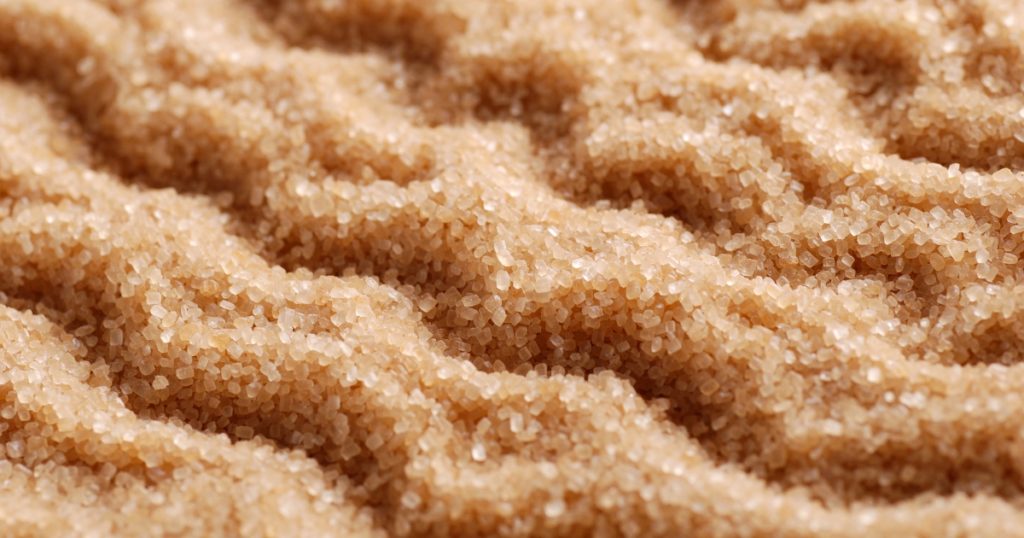
Light brown sugar, a staple in baking, offers a golden brown color and caramel flavor to baked goods. It contains about 3.5% molasses, adding moisture and chewiness that you don’t get from white sugar.
Dark brown sugar, on the other hand, with nearly twice the molasses content at around 6.5%, brings a deeper color and more robust flavor to recipes. This difference means using any brand of dark brown sugars instead of light can significantly affect the moisture, taste, and color of your baked goods, making them darker and more intensely flavored.
Oh and cool trivia: if you need it but you don’t have any, you don’t have to look for any substitute for brown sugar; you can just make your own! Just mix 1 cup of white sugar with 2 tablespoons of molasses for homemade light brown sugar. For dark brown sugar, simply increase the amount of molasses.
11 Types Of Sugar #3: Confectioner’s Sugar

Confectioner’s sugar, also known as powdered sugar or icing sugar, is finely ground regular white sugar and sifted to make a smooth powdery texture. Cornstarch is then added to the powdered sugar to prevent it from caking.
This fine sugar dissolves easily, making it ideal for frostings, icings, and ensuring a tender texture in baked goods. You can use this to dust, say, donuts and other sweets for visual and flavor appeal. It’s also perfect for sweetening whipped cream without the grittiness of granulated sugar.
Want to make your own at home? Just mix 1 cup of granulated sugar and blend it with one tablespoon of cornstarch in a food processor. Voila!
11 Types Of Sugar #4: Cane Sugar
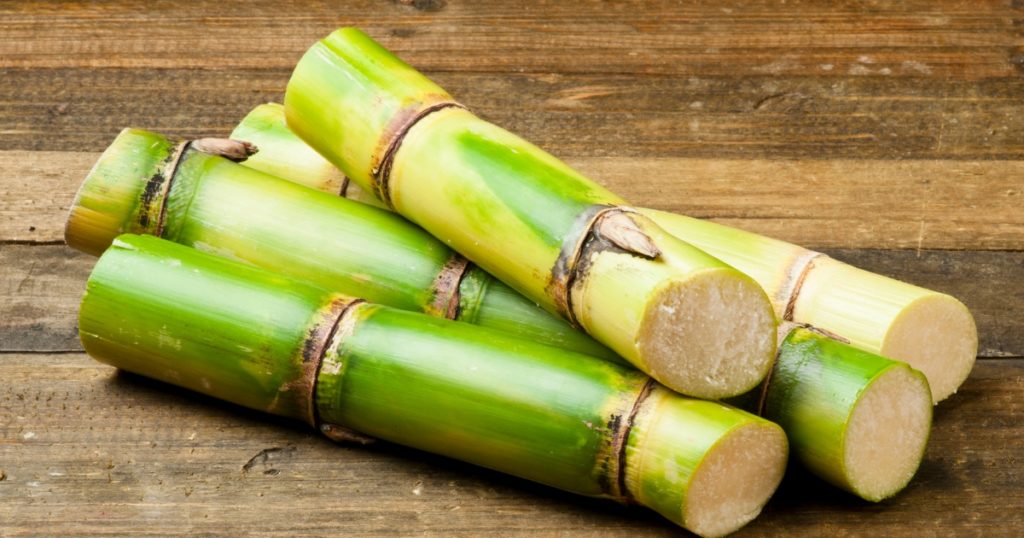
Cane sugar comes directly from the sugarcane plant and is less processed than granulated white sugar, retaining a bit of the natural molasses flavor and color. This sugar is known for its slightly larger crystals and a richer taste compared to standard white sugar.
In baking, cane sugar is a fantastic choice for bakers looking to add a hint of molasses flavor and a touch of richness to their creations without straying too far from the familiar results of white sugar. That’s especially true since it offers a subtle depth of flavor that enhances the overall taste of baked goods. It’s particularly good in recipes where a caramel-like sweetness is desired, such as in crumbles.
A note though: given its slightly larger crystal size, ensure it’s fully dissolved in mixtures to avoid a gritty texture, especially in beverages or fine pastries.Oh and one more cool note: Studies show that cane sugar contains high levels of polyphenols – potent antioxidants that can neutralize damaging free radicals in the body. Unlike regular white sugar, cane sugar also retains some vitamins and minerals from the sugarcane plant such as calcium, magnesium, and potassium. While moderate use is still advised, these nutrients give cane sugar a bit of an advantage over white sugars.
11 Types Of Sugar #5: Caster Sugar

Caster sugar is also known as superfine sugar. This sugar dissolves more quickly than regular granulated sugar, making it highly preferred for delicate baked goods like soufflés that need a certain mouthfeel. This type of sugar is also ideal for making meringues and cocktails, since it blends seamlessly into mixtures, ensuring little to no grittiness.
It’s a favorite for bakers who create exquisite desserts!
11 Types Of Sugar #6: Muscovado Sugar
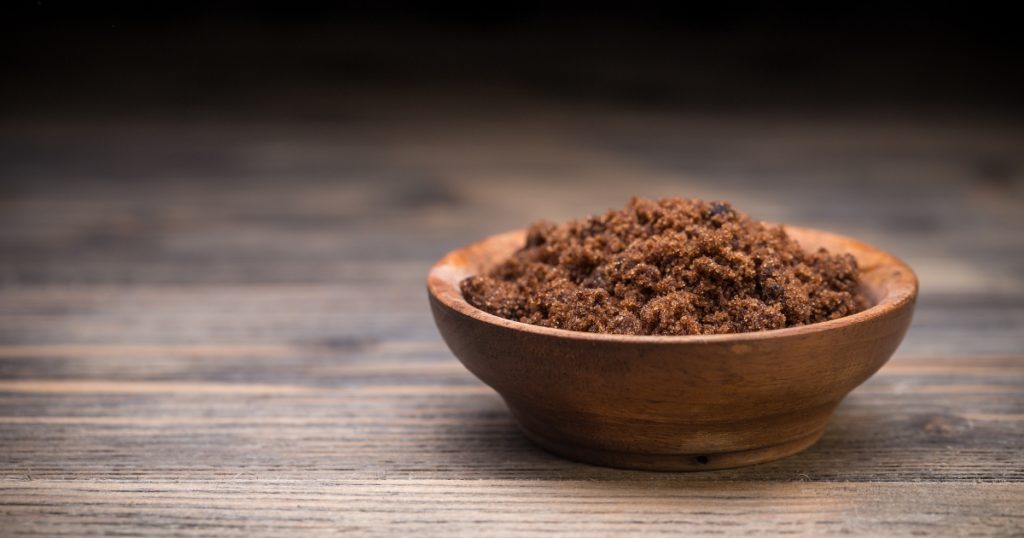
Muscovado sugar is a minimally processed sugar type. It’s a sugar with high molasses content, a rich complex flavor, and a moist sandy texture—it will remind you of butterscotch, actually. Its strong flavor is much more pronounced than that of traditional brown sugars, making it a distinctive choice for both sweet and savory dishes.
Muscovado sugar shines in recipes where its robust flavor can stand out, such as in molasses cookies, gingerbread, and rich chocolate cakes. It adds depth and complexity to desserts that benefit from its bold molasses notes.
Its rich taste is also a great addition to savory sauces and marinades, offering a balance of sweetness with a hint of bitterness. It can transform barbecue sauces, glazes, and even slow-cooked meat dishes.
And of course, it’s perfect for coffee!
11 Types Of Sugar #7: Raw Sugar (Turbinado And Demerara)
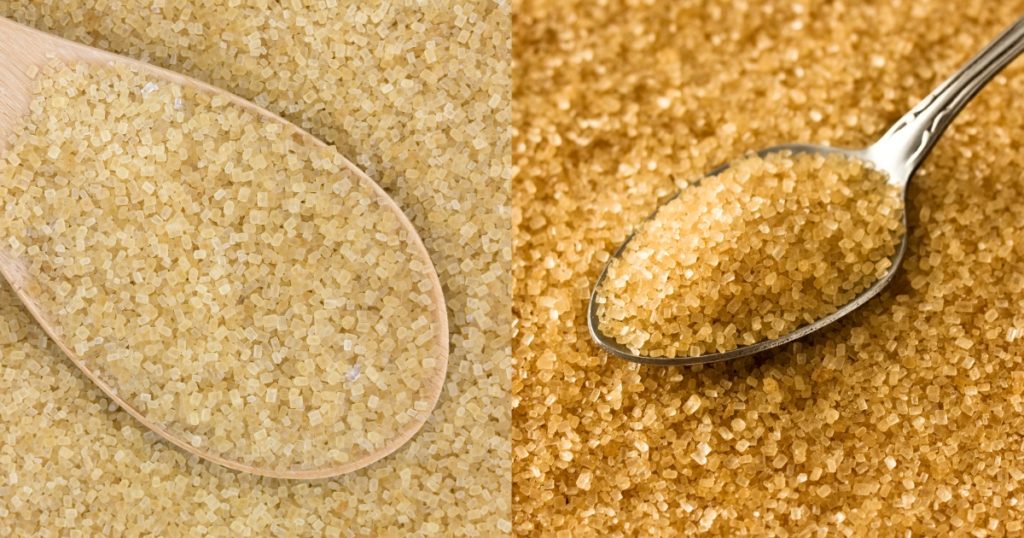
Raw sugars like Turbinado and Demerara are less processed than white refined sugars, retaining a natural golden-brown color and a slight molasses flavor. Turbinado sugar has large, sparkling crystals and a subtle caramel taste, while Demerara sugar has slightly larger crystals and a richer flavor profile. Raw sugars retain a light coating of molasses, unlike fully refined sugars that have the molasses completely stripped away. This gives raw sugars their distinctive color and taste.
Turbinado sugar’s larger crystal size and mild flavor make it ideal for topping muffins, cookies, and crumbles, adding a crunchy texture and a hint of sweetness. On the other hand, Demerara sugar’s richer flavor and crunchy texture work well in coffee, tea, and on top of baked goods. It’s also excellent for creating a caramelized crust on desserts like crème brûlée or sprinkled over fruit before baking.
11 Types Of Sugar #8: Liquid Sugar

Want liquid sugar? Just dissolve sugar in water and get a clear, sweet syrup. This form of sugar is ideal for beverages, such as coffee and tea, but it also has its place in baking and cooking.
Its main advantage in the kitchen is its ability to blend seamlessly into mixtures, eliminating the need for dissolution that granulated or powdered sugars require. This makes it particularly useful for moist cakes, sweet breads, and smooth sauces and glazes where a consistent sweetness is crucial.
11 Types Of Sugar #9: Sanding Sugar

Bakers often use sanding sugar’s large, coarse crystals that sparkle and shine to add a decorative touch to baked goods. Unlike finer sugars, sanding sugar retains its texture and appearance even after baking, providing a beautiful, glittery effect on the surface of cookies, cakes, and pastries. Its availability in various colors further enhances its appeal, allowing for creative and vibrant decorations that catch the eye—perfect for holiday treats!
For best results, sprinkle sanding sugar on top of cookies, scones, or muffins just before baking. This ensures the sugar adheres well to the surface and maximizes its sparkling effect. You should also brush your bakes with a light egg wash to make the crystals stick better and stay in place.
11 Types Of Sugar #10: Pearl Sugar

Pearl sugar, sometimes called nib sugar, consists of large, white, opaque granules that retain their shape and do not melt during baking. You use this kind primarily for decoration, adding a crunchy texture and a visually appealing finish to baked goods. It has a coarse hard texture and is opaque in color.
Pearl sugar is perfect for professional or home bakers looking to add a distinctive crunch and decorative flair to their baked creations. Mix it into doughs for items like Belgian waffles or sweet breads for pockets of sweetness. You can also use pearl sugar as a finishing touch on frosted cakes, rolls, and buns for added texture and visual appeal.
11 Types Of Sugar #11: Coconut Sugar
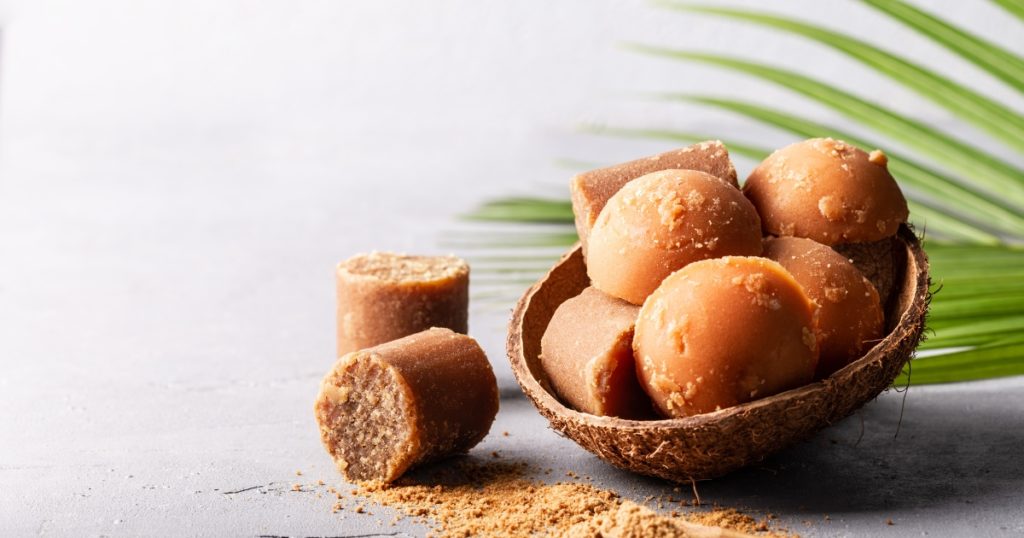
You get coconut sugar from the sap of the coconut palm tree. Among the variety of sugars, people know coconut sugar for its lower glycemic index compared to regular white sugar, making it a popular choice among those looking for healthier sugar alternatives. It also contains trace amounts of vitamins, minerals, and phytonutrients, adding a slight nutritional edge.
Flavor-wise, coconut sugar offers a subtle caramel-like taste, which can enrich the flavor profile of baked goods with a deep, warm sweetness.
Exploring the Sweet Possibilities: What’s Next?
Now that you’re familiar with these common sugars, it’s time to put this knowledge into action. Each type of sugar offers unique properties and flavors that can transform your baking and cooking, elevating simple recipes into something truly special. Here’s how to take the next steps in your culinary journey:
- Experiment with Substitutions: Start by substituting different sugars in your favorite recipes. Use coconut sugar instead of white sugar for a healthier option, or try muscovado in place of brown sugar for a deeper flavor. Remember, the key is to consider the moisture content and flavor profile of each sugar type.
- Adjust Recipes to Taste: As you experiment, adjust recipes based on the sweetness and flavor of the sugar you’re using. Some sugars are sweeter than others, so you may need to use less to achieve the desired taste. Additionally, the unique flavors of sugars like coconut or muscovado can add an unexpected twist to classic dishes.
- Focus on Texture and Color: Consider how the sugar affects the texture and color of your baked goods. For example, pearl sugar adds a delightful crunch to waffles and breads, while sanding sugar gives a sparkling finish to cookies and cakes.
- Creative Decorations and Finishes: Use sugars not just for their sweetness but as decorative elements. Experiment with colored sanding sugars for festive occasions or use powdered sugar for a delicate, snow-like dusting on desserts.
- Moderation is Key: As we discover new types of sweeteners for baking, we must also consider their impact on well-being. Consume sugar moderately. Striking a balance allows us to enjoy sweets without excess. We may even wish to explore sugar substitutions (i.e. the ones used for keto recipes) to support dietary needs. There are ways to craft delicious recipes while being mindful of our bodies.
Final Thoughts
Learning about the different common types of sugar is the first step to transforming your baking. Each sugar adds its own flavor and texture, letting you get creative in the kitchen. Whether trying healthier coconut sugar or experiencing the molasses taste of muscovado, the right sweetener can take your recipes from good to great.
I encourage you to experiment with these unique sugars in your baking projects. It’s not just about new tastes – it’s about making even better desserts. So grab an apron and see what sweet ideas you can whip up!
If you want to improve your skills more, The Bailiwick Academy offers fun baking and cake decorating classes. Sign up at The Bailiwick Academy today and try one of our courses now!
—
Keep coming back to The Bailiwick Academy blog for more cooking and baking tips, kitchen tricks, and much more!
]]>I hope you get inspired by them!
Why Catering Is A Big Opportunity in 2024
2024 is shaping up to be a great year for starting a catering business. What makes me say this, you ask?
- There are already projections of more business meetings and corporate events this year. And if you remember one of my tips for standing out as a catering business, it’s to close plenty of corporate clients. 2024 makes it super possible to succeed in catering.
- There are always weddings here in the Philippines. For example, according to the Philippine Statistics Authority (PSA), the number of people who got married increased from 2019 to 2022. I’m pretty sure the same thing happened in 2023, and will happen in 2024!
- And of course, Filipinos love to party and celebrate special occasions such as baptisms or birthdays. And with celebrations always come food, which means more catering opportunities success—and income!
Those three are more than enough reasons, wouldn’t you agree?
How To Really Succeed In Catering
Are you now really, REALLY encouraged to try your hand at catering this 2024? I hope so, especially if you’ve been dreaming of coming up with a cooking and baking empire for a long time already!
Now, how exactly do you go about it? Sure, I gave you seven tips to get started on a catering business… but I feel like the best way to really find out is to check out some of the best caterers in the Philippines!
I did a quick search, found this list, and this list, and found some commonalities of what makes them great, according to the lists:
- Delicious food of different cuisines
- Great service
- Beautiful setups
- An overall amazing experience
But here’s the thing: knowing what makes a great caterer and actually implementing these things are two different sides of the coin.
Besides, even if you know, how can you be sure that you can apply the knowledge and actually achieve catering greatness?
Well, that’s where Catering 101 of The Bailiwick Academy comes in!
Succeed in Catering in 2024 With Catering 101
Our Catering 101 course is like a training camp for caterers, perfect for enthusiastic home cooks like you.
You’ll pick up skills to make your catering business really stand out. This includes learning effective marketing, creating a memorable menu, and setting the right prices to ensure good profits.
We’ll show you how to smoothly handle tough situations and demanding customers. Plus, you’ll learn ways to make such a great impression that your customers will be eager to return.
This course is filled with tips and tricks from some of the Philippines’ top caterers and chefs.
By the end of it, you’ll be ready to handle big events, lead a great team, and have the know-how to expand your catering business.
Who will be teaching Catering 101?
We were on the lookout for caterers who could help us make this class really comprehensive… and we’re lucky that we already have onboard Chef Him Uy De Baron!
Chef Him is hailed as one of the biggest names in the culinary world, Chef Him runs various restaurants all over the Philippines and is one of the instructors inside The Bailiwick Academy since 2022.
Check out the preview of this class here:
But it’s not just Chef Him. Meet the others:
- Beejay Tantoco, who runs his family catering business Tantoco’s Catering (established in 1994) where they close government accounts, serve celebrities, and entered popular food markets like Mercato and Bancheto.
- Chef Kalel Chan, a corporate chef of Raintree Restaurants which operates 10 restaurants — Farmer’s table, Saboten, Cha Cha’s Boracay, The Coconut Club, Izakaya Sensu, My Country House, Jones All Day, and so much more. He’s famous for The Original Ube Champorado!
- Aileen Ferrer, a Bailiwicker, our community manager of the TBA Student Lounge, and a businesswoman who runs “Unwrapped – Flowers, Hampers and Events” — a flourishing floral and event styling company that works with corporate clients, weddings, and various events.
- Michelle Lazaro, another Bailiwicker who runs Balai Calamba, a catering business based in Laguna. She also owns two commercial kitchens strategically located in Las Piñas and Laguna. She has catered for corporate events of Hyundai, Chery, and Foton.
- We also have a mystery chef! He has been in the food business for almost 20 years. His experience includes working for Nestle as a Regional Chef Consultant, running a Catering Business since 2004, and starting a new food business last 2022. You’ll find out who he is when you join the program!
How Catering 101 Will Go
Catering 101 starts on January 28, 2024, and will be broken up into six strategic modules to help you succeed in catering.
Week 1: Laying the Foundations For a Successful Catering Success
This week, you’ll dive into the essentials of starting a catering business. This includes understanding the market, the diverse roles in catering, and what initial capital you’ll need. You’ll also learn about building a strong team, crucial for a successful operation.
- Discover the catering market opportunities, especially in the Philippine context.
- Learn directly from industry experts about starting a catering business, covering everything from capital needs to logistics.
- Understand the various roles you’ll play, from chef to business strategist.
- Get a detailed breakdown of initial capital requirements for budget planning.
- Learn how to assemble a strong team, including roles like event managers and chefs.
- Gain real-world insights from successful caterers on launching and growing your business in the Philippines.
- Balance your passion for food with the skills needed for running a successful business.
Week #2: Crafting a Unique Brand that Makes Sales and Marketing Simple
Week 2 focuses on branding, sales, and marketing in the catering industry. You’ll learn how to differentiate your business in a competitive market and make an impact.
- Understand the different catering types and their unique needs.
- Learn how to evaluate your competition and identify your unique selling points.
- Gain insights from real-life examples on effective brand positioning.
- Learn how to engage potential clients with compelling sales pitches.
- Create a targeted marketing plan and schedule.
- Learn the steps for testing your business concept before a full-scale launch.
- Understand the importance of maintaining good relationships in corporate catering.
Week #3: Create Irresistible Menus and Aesthetically-Pleasing Meals Like a Catering Pro
In Week 3, you’ll delve into menu planning and food presentation, learning how to create menus that are both delicious and practical for catering.
- Explore various menu styles and learn how to select the best for different events.
- Learn recipe selection that’s both tasty and catering-friendly.
- Understand the challenges of catering food, including logistics and quality maintenance.
- Acquire skills in food presentation to enhance event dining experiences.
- Learn essential food safety practices.
- Manage supplies effectively and build strong supplier relationships.
- Get advice on setting up an efficient off-site kitchen.
Week #4: Costing and Pricing Best Practices to Maximize Profits
This week is all about the financial side of catering, focusing on recipe costing, pricing strategies, and understanding overhead costs.
- Learn to cost recipes accurately and understand their financial impact.
- Develop effective pricing strategies that reflect your service’s value.
- Understand the overhead costs involved in catering.
- Design profitable and appealing menus.
- Develop financial management skills for long-term success.
- Balance cost-effectiveness with high-quality offerings.
- Adapt pricing strategies to market dynamics and customer expectations.
Week #5: Master the Essentials of Booking, Service, and Crisis Management
The fifth week covers the practical aspects of managing catering events, from booking to service standards and crisis management.
- Learn the comprehensive process of booking events.
- Master creating a BEO for outlining event details.
- Develop a culture of excellent service in your team.
- Handle crises and difficult clients professionally.
- Follow up with clients post-event for feedback and repeat business.
- Use successful events as marketing tools while respecting client privacy.
Week #6: The Essentials of Table Styling for Every Occasion
In the final week, you’ll learn the art of table styling, ensuring your setups are as memorable as your food.
- Learn to set up buffet and dining tables for various events.
- Choose the right serving and dinnerware to enhance the dining experience.
- Discover flower arrangement tips for stunning table displays.
- Customize table setups for different themes.
- Receive step-by-step instructions for flawless table presentations.
By the end of these six weeks, you’ll have a comprehensive understanding of starting and running a successful catering business, equipped with practical skills and insider knowledge!
How To Enroll In Catering 101
It’s easy! All you have to do is sign up at The Bailiwick Academy then go over to the Catering 101 Page. Enroll, and then make sure to block off January 28, 2024, as that’s the first day of class!
Final Thoughts About How To Succeed in Catering in 2024
Looking ahead to 2024, it’s clear that there’s a big chance for success in the catering business. With more companies holding events, lots of weddings, and Filipinos loving big celebrations, there’s plenty of work for caterers.
To really do well in catering, you need to mix your love for cooking with smart business skills. That’s where our Catering 101 course at The Bailiwick Academy comes in. It teaches you everything from understanding what customers want to making your catering stand out, to handling money matters.
You’ll learn from experts like Chef Him Uy De Baron, who know all about making great food and running a successful business. They’ll share their secrets on how to make your catering unforgettable and how to handle any tough situations that come up.
Don’t miss this opportunity to turn your passion into a profitable venture! Become one of the Bailiwickers trained by successful food business owners on how to launch a catering business in 2024.
Join Catering 101 today. See you inside!
—
Keep coming back to The Bailiwick Academy blog for more baking and cooking tips, kitchen tricks, and much more!
]]>Well, read on to ensure that as much as possible, it’s your name—and your menu—on everyone’s lips!
Catering Tips 1 of 5: Close Corporate Catering Clients—And Stay Friends With Them!
Out of the many catering tips for your next corporate event, here’s one to keep in mind. Why? Well:
- Corporate clients often host multiple events throughout the year, providing a steady stream of opportunities. Research corporate events and you’ll find plenty of variations: team buildings, awarding ceremonies, recognitions, Christmas parties, and so on. Imagine being able to cater for all those!
- Satisfied corporate clients are likely to recommend your services to other businesses and colleagues.
- Corporate events often have larger budgets, allowing for more creative and expansive catering options. Of course, they may have higher expectations as well, but I’m sure you’re more than able to meet that challenge!
- Catering for corporate events can increase your brand’s visibility among a wider, professional audience. That’s especially true since these events are great for networking, potentially leading to more business and partnerships. Of course, this means you need a team to do everything for you while you network and shake hands—don’t forget this part!
At the end of the day, you need leads and returning clients to survive—money, after all, is the lifeblood of all businesses. Corporate clients help you achieve that. By nurturing strong relationships with them, you’re doing more than just catering – you’re creating a supportive network for your business.
Catering Tips 2 of 5: Specialize In A Catering Style
If you read Chef Joey Prats’ spotlight in this blog, you’d know that one of the things he advocates for is focusing on one product. That way, you can go all in on creating the product and becoming known for it.
Well, guess what? You can apply the same concept to your catering. Specializing in a particular style or type of cuisine can set you apart from competitors.
Whether it’s gourmet, vegan, local cuisine, or themed events, having a niche makes your service unique and memorable. By specializing in a certain type of food or style, like gourmet, vegan, or local dishes, you become the go-to person for that special kind of catering. It’s a great way to draw in customers who want exactly what you offer and to build a name for yourself as the expert in your chosen area.
Catering Tips 3 of 5: Develop “Travel-Friendly” Food Selections And Solutions
One challenge when it comes to preparing food ahead of time is transportation. No one wants their beautifully prepared dishes to turn into a messy, unappetizing heap during the journey, agree? That’s why developing a menu with “travel-friendly” food selections is so important.
Here’s how to ensure your dishes remain appealing and delicious, even on the go:
- Opt for foods that can withstand travel to the event space without losing their appeal. Baked goods, casseroles, and sturdy salads are great choices.
- Select items that stay fresh at room temperature or can be easily reheated without compromising quality.
- Food safety is important! Use containers that protect the food, maintain food temperature (both hot and cold), and prevent cross-contamination and spills or messes during transport.
- Conduct trial runs to see how dishes fare during transport to the event space, adjusting recipes or packaging as needed.
- Ensure that the food still looks appetizing upon arrival, considering factors like sauce separation or garnish displacement.
- Design dishes that are easy to plate quickly and attractively at the event location, minimizing on-site prep work.
Remember, in catering, how your food travels is just as important as how it tastes! Considering these factors ensures that your food is always served at its best, leaving a lasting impression on your clients and their guests.
Catering Tips 4 of 5: Create Crisis Management Protocols
According to cvent, there are different types of caterers: front-facing caterers who help with setup and guest relations; catering chefs who stay in the kitchen; and catering managers who oversee the entire catering team of servers and cooks.
However, as the business owner, whether you prefer front-facing catering or staying in the kitchen as the catering chef, you’ll have to be prepared for any crisis that may arise. And yes, in the catering business, unexpected situations are bound to arise!
Here’s how you can create effective crisis management protocols to save the day:
- Understand the types of emergencies that could occur, such as food shortages, equipment malfunctions, or staffing issues.
- For each potential crisis, have a clear plan of action. This might include backup suppliers, extra equipment, or a pool of on-call staff.
- Ensure every team member knows their role in a crisis. Regular training sessions can help keep everyone prepared and confident.
- Establish clear lines of communication for quick and effective coordination during a crisis.
- Of course, don’t forget that as your business grows and changes, so should your crisis management plans. Regularly review and update them to ensure they remain effective.
By having solid crisis management protocols in place and being prepared for the unexpected, you show professionalism and can significantly enhance your reputation in the industry.
Catering Tips 5 of 5: Catering A+++ After Service
Out of all the catering tips here, this might be the most important.
You know what pro caterers do when they’re done with the event? They don’t just pack up and leave! They make sure that they have excellent after-service.
Here’s why and how to excel in after-service:
- Reach out to your clients to ask for their feedback. This shows that you care about their experience and are always looking to improve. Constructive feedback is invaluable for refining your service and menu.
- A simple thank you note or call to your clients can go a long way. It demonstrates your appreciation for their business and helps in building a lasting relationship.
- Use the follow-up as an opportunity to discuss future events. Inquire about any upcoming events they might be planning and how you can be a part of them. This proactive approach can secure future bookings.
- If your clients are happy with your service, ask them to refer you to others. Word-of-mouth is a powerful tool in the catering industry, and satisfied clients are often your best advocates. Try getting them on video talking about their experience with your company.
- Keep your clients in the loop about your new services, menus, or special offers. Regular, non-intrusive communication keeps you at the forefront of their minds for future catering needs.
- If a client has any complaints, address them promptly and professionally. How you handle issues can sometimes leave a more lasting impression than the service itself. Be as nice and graceful as possible, and remember that most people aren’t trying to be difficult; they just want someone to listen to them and give them a solution to their problem.
Final Thoughts
In wrapping up, these five catering tips are your roadmap to not just surviving but thriving in the competitive world of catering. By implementing these tips, you’re setting yourself up for success and longevity in the catering business. Remember, it’s not just about serving great food; it’s about creating an entire experience that resonates with your clients.
Ready to start your catering business but you don’t know where to start? Watch for my next blog post. I’ll be featuring some successful caterers, what they did, and how you can copy some of their methods to start a catering business of your own this 2024!
And before I go, I’d just like to remind you: don’t forget to sign up at The Bailiwick Academy for recipes you can use in any catering event!
—
Keep coming back to The Bailiwick Academy blog for more baking and cooking tips, kitchen tricks, and much more!
]]>Keep on reading as I walk you through these key processes to get your home-based catering business off the ground.
1st Step For Starting A Catering Business: Conduct Thorough Market Research
The first step in starting your catering business is to really get to know your market. This includes doing the following:
- Figuring out who would want your catering services and what kind of food they like. Are people in your area into fancy wedding banquets, or do they prefer casual birthday parties, or is there a demand for vegan and/or gluten-free menus?
- Think about the prices people are willing to pay and what times of the year get really busy with events. This part of the job might involve some online research, talking to people, and maybe even checking out different types of events to see what’s popular. Getting this step right sets you up to create a business that really fits into your community and stands out from the competition.
Understanding what people around you want and what other catering businesses are offering (or not offering) can help you find your own special spot in the catering world.
What happens if you skip market research?
Not doing market research when you start your catering business is like trying to hit a target while blindfolded. This means you might make a menu that doesn’t fit what people in your area are looking for. For example, you could end up offering fancy, expensive dishes in a place where people prefer simple, affordable food, or the other way around.
Also, you might set your prices too high and scare customers away, or too low and not make enough money. Plus, you could miss out on finding a special service or dish that nobody else is offering to any potential client. In short, skipping market research can lead to making bad choices for your business, wasting time and money, and having a hard time getting and keeping customers.
2nd Step For Starting A Catering Business: Develop a Solid Business Plan
After you’ve got a good handle on the market, the next big step is to make a solid business plan. Make sure it includes the following:
- How much you’ll charge for your services, who you want to cater to (like weddings, parties, or corporate events), and how you’ll let people know about your business.
- How much it’ll cost to start your business, keep it running, and make a profit.
Having a clear business plan helps you stay focused and organized. Plus, if you ever need to make business loans or get investors, it’s ideal to have a plan that shows how making an investment in you is a good idea!
What if you start running your business without a plan?
Sure, you can start your catering business without a plan, but there’s a good chance things won’t turn out right. Without a business plan, you might experience these:
- Spending money too fast
- Finding yourself in situations where you’re not prepared, like a big event that you don’t have enough staff or supplies for.
- A hard time tracking goals and progress—you might not know if you’re making enough money to cover your costs or if you’re charging the right prices.
In short, without a plan as a basis or something to fall back on, you’re going to make things riskier and stressful for yourself.
3rd Step For Starting A Catering Business: Get the Necessary Licensing and Permits
This particular step is important because you want to be a legitimate and legal business entity, even if you’re just operating out of your own kitchen space. That means making sure you have all the right licenses and permits. Depending on where you live, you’ll need different kinds of permits, like a food handler’s license, a health department permit, and maybe a general business license.
Getting these licenses might seem like a lot of paperwork and maybe a bit of a hassle, especially when you just want to start a catering business in the Philippines, but trust me. It’s worth it for your own peace of mind and for customers to trust that they’re eating food that’s safe and prepared in a clean environment.
What are the consequences of skipping this step?
If you don’t go through the proper steps and channels, you could get into legal trouble, which can mean fines or even having to shut down your business. Additionally, operating without the necessary permits can damage your reputation. If word gets out that you’re not properly licensed, it can be really hard to build trust with potential clients and make it difficult for your catering operation to grow and succeed.
4th Step For Starting A Catering Business: Create a Memorable Brand and Marketing Strategy
A good marketing strategy gets your name out there and brings in customers. Do the following to accomplish this:
- Think about what makes your cooking or your service special and use that to build your brand.
- Your brand is what makes you different from all the other catering companies out there, so make sure it’s memorable—come up with a catchy name, a logo, and even a unique color scheme.
- Don’t just stop at having a brand—you need to let people know about it via a marketing strategy. You can use social media, like Facebook or Instagram, to show off your food and tell people about your services.
- You could also make a website, hand out flyers at events, or team up with local event planners.
What if you don’t take the time to make a brand and strategize your marketing?
If you don’t invest time in building your brand or your marketing strategy, you’ll struggle to stand out in the competitive catering industry, making it hard to attract and retain customers. Without a way to spread the word about your services, many potential clients won’t even know your business exists. This lack of visibility can lead to fewer bookings and limited growth opportunities.
5th Step For Starting A Catering Business: Plan Your Menu Carefully
Since you are running a food business, it’s super important to think about what types of food you’re going to offer. Here are some things to keep in mind.
- Your menu is like your business card—it shows off what you can do. Make sure it has a good mix of different kinds of dishes so you can please all sorts of customers.
- As mentioned above, include things for people who might be vegetarian, or who don’t eat gluten, so everyone has something they can enjoy.
- Think about how much the ingredients cost and how long each dish takes to make. You want a menu that’s not just tasty but also doesn’t cost too much to make or take too long to prepare.
Can’t I just offer whatever food people look for?
There’s always the temptation to offer a wide range of foods that people are looking for, but it’s not always the best idea. Why?
- If you try to make too many different kinds of food, you might need lots of different ingredients and a lot of time to prepare everything. You’ll end up overexerting yourself which can affect the quality of your service and your food.
- As Chef Joey Prats says in this feature, it’s better to focus on a few things. This way, you can make sure the quality is always top-notch, and you won’t get overwhelmed. Plus, having a speciality can make your catering business stand out from others.
6th Step For Starting A Catering Business: Invest in Quality Equipment and Supplies
The sixth step is to make sure you have the right tools and supplies for your catering operations. This means:
- Getting things like reliable stoves, sharp knives, and sturdy pots, pans, and chafing dishes.
- Think about what you need for serving the food, like trays, dishes, and utensils.
- Note that it’s worth spending a bit more on these because they’ll help you cook better and faster, and they’ll last longer.
- Find some trustworthy suppliers who can give you fresh and high-quality ingredients. Having good supplies means your food will taste better, and that’s what will make your customers happy.
Can’t I save up by just spending on less-than-quality equipment?
You might think you’re saving money upfront by buying cheaper, lower-quality equipment, but it can actually cost you more in the long run:
- Low-quality equipment often breaks down more easily and doesn’t perform as well.
- You might end up with food that’s not cooked properly or you could face delays in your service as your business grows.
- This can disappoint your customers and hurt your business’s reputation.
- You’ll also likely have to replace or repair cheap equipment more often, which adds up over time.
Investing in good-quality equipment is a smarter move because it’s more reliable, lasts longer, and helps you maintain a high standard of service.
7th Step For Starting A Catering Business: Hire and Train a Skilled Team
If you want your catering business to last, you’ll have to admit to yourself that you’ll need a team. Even if you’re great at cooking, you can’t do everything alone, especially as more orders come in. You’ll need chefs, servers, and maybe even a person to help with cleaning or deliveries.
Look for people who are not only good at their jobs but also friendly and professional because they represent your business. Once you’ve got your team, it’s important to train them well. Make sure they know how to prepare and serve food the way you want, and that they understand the importance of customer service.
Is hiring and training a team really necessary?
Like I said earlier, you can’t do everything yourself. A well-trained team can make a huge difference in how smoothly your events go and how happy your customers are. They can help you handle bigger jobs and make sure everything runs on time.
Plus, having a team allows you to focus on the parts of the business where you excel, like creating menus or networking with clients, while they handle the day-to-day tasks. It also means you can take on more events and grow your business faster.
Final Thoughts
Starting a catering business, especially from home, is an exciting journey filled with opportunities and challenges. But by following these seven steps, you’ll be well on your way to launching a successful catering business in 2024.
Of course, I’d want to help make you even more successful. That’s why you should watch for my next blog post, where I’ll talk about simple hacks to get more business and referrals as a startup catering business. These tips will be invaluable in expanding your client base and enhancing your brand’s reach.
Stay tuned! And while you’re here, don’t forget to sign up at The Bailiwick Academy to access courses that will inspire and expand your future catering menu options!
—
Keep coming back to The Bailiwick Academy blog for more baking and cooking tips, kitchen tricks, and much more!
Well, I’m not going to lie to you; it can be very scary to think about, but it’s also totally possible! And in this blog, we’re going to explore the idea of starting a catering business from home.
Let’s dive in and find out how you can make this home-based catering business happen!
Who is a home-based catering business for?
If you have a passion for cooking and enjoy making others feel welcome, then starting a catering business from your home might be the perfect fit for you. This business model is especially great for stay-at-home parents who are looking to balance family life with a fulfilling career, aspiring chefs eager to showcase their culinary talents, or anyone wanting to move away from the regular 9-to-5 routine in favor of something more personally rewarding.
Keep in mind, though, that it takes a good dose of discipline, strong organizational skills, and a touch of creativity to truly stand out in the busy catering market. But if you’re up for the challenge, this could be an exciting and fulfilling path for you!
Catering Business From Home: More Than Just Being A Good Cook
Starting a catering business takes a lot more than just being good at making tasty food. Here’s a look at some things you need to consider when starting out to make your home-based catering business a success.
Know Who You Want To Serve
First things first, you need to figure out who wants to eat your food. Do you want to cook for birthday parties, weddings, and other special occasions, or small get-togethers and celebrations that call for food? Knowing your wanted target market helps you decide what kind of food to make and how to advertise your business.
Learn The Business Side
When you decide to run a home business, you won’t just be a home cook. You’ll have to think of yourself now as an actual business owner, like a restaurant owner or a food truck owner. You’ll now have to think about your menu, your menu pricing, how to keep track of your money, and different marketing strategies to let people know about your business.
Stay Safe And Legal
With this business model, making sure your food is safe to eat is super important. You’ll need to know and follow the rules about food safety and maybe get your kitchen checked out by the health department and get the necessary health permit. This keeps you and your customers safe.
Oh and of course, you’ll have to get a business license to keep things legal.
The Work Catering Business At Home Entails
Now that we’ve gotten some of the planning out of the way, the next step is looking at some aspects of the day-to-day work it entails. In no particular order, here are some to keep in mind.
Menu Planning, Food Preparation, and Presentation
A significant part of your day will be spent on menu planning. This can get complicated because you’ll have to create a cohesive menu that appeals to your clients, fits their event theme, and works within their budget. And once the menu is set, there’s the food preparation, which involves sourcing fresh ingredients, prepping them, and ensuring each dish is cooked to perfection.
Let’s not forget presentation—the way the food looks on the plate is just as important as how it tastes. This requires a creative eye and attention to detail.
Customer Service and Marketing
Customer service is key in the catering world. You’ll be communicating with clients, understanding their needs, and ensuring their satisfaction. This could mean answering emails, taking calls, and sometimes dealing with last-minute changes or special requests.
Marketing is another crucial aspect. You will have to manage your business’s social media profiles, update your website, and create content like blogs or videos to engage potential clients.
Networking, both online and in person, is also part of marketing. Building relationships with Getting to know people who can help your business is a big deal. This could be event planners, other businesses that can help you, or customers who can do word-of-mouth marketing for you to make other people patronize your services and give you more opportunities.
Administrative Tasks
Administrative tasks include everything from managing bookings and invoices to keeping track of expenses and ensuring you’re compliant with any local business regulations. Good organizational skills are essential here to keep everything running smoothly.
Physical and Mental Demands
It’s important to acknowledge that catering can be physically demanding. You’ll be on your feet for extended periods, sometimes lifting heavy pots or standing over a hot stove for hours. It’s not just a physical challenge but a mental one as well. Each event comes with its own set of intricacies – from special dietary needs to ensuring the timing of each course is spot on.
Planning Your Time
Catering can get busy, especially when you have a lot of orders. You need to be good at planning. This means knowing when to shop for ingredients and to restock your pantry, when to start cooking, and how to get everything ready without rushing at the last minute.
Being Ready for Anything
Sometimes, things don’t go as planned. Maybe you need to change a menu quickly, some of your food handlers called in sick, an event planner is not being cooperative, or you’ll need to handle a difficult client at an event. Being able to think on your feet and solve problems fast is a big part of catering.
Work Hard AND Smart
Based on the above, we can conclude that like any home-based businesses, a catering business out of your home will take a LOT of work. But that doesn’t mean you have to do it all—that won’t be an efficient use of your time. Let’s see some ways you can make home catering easier for you.
Make Friends with Efficiency
Think of your kitchen as your command center. Organize it so everything you need is right at your fingertips. Plan your menus to make the most of your ingredients and time to make everything flow smoothly.
Embrace Technology
Think of technology as a helpful friend who’s always there when you need them. Use apps for keeping track of ingredients, social media to show off your delicious dishes, and online tools for all the behind-the-scenes business stuff.
Love Numbers
You may not really like math, but keeping an eye on your finances can actually be fun (really!). Think of it as the scorecard of your business – it tells you how well you’re playing the game. Grow to love numbers, and you’ll be able to set prices that make sense as well as know where your money’s really going.
Ask For Help When You Need It
Remember, even superheroes have sidekicks. As your business grows, it’s okay to delegate and get help. Maybe it’s someone to serve as an extra pair of hands in the kitchen or someone to do social media for you. It frees you up to focus on what you do best: making amazing food.
Factors To Consider For Running A Food Business Out Of Your Home Successfully
Once you’ve got your home catering business going, the next step is to keep it successful for years to come. Here are some easy-to-follow tips to help you do just that:
Update Your Home Catering Business Plan Regularly
Think of your business plan like a garden – it needs regular care to grow. As things change in your business and the world around you, update your plans. This might mean trying new types of events or changing how you manage your money.
Keep Your Customers Happy
Happy customers are the key to a successful business. Always try to make their experience with you something special. Pay attention to the little things, listen to their needs, and try to give them more than they expect. They’ll likely tell their friends about you, which can bring in more business.
Keep Up with Trends
Stay in the loop with what’s new in catering and food. This could be new food trends, ways of serving, or even tech tools that make your job easier. Being one step ahead can make your business stand out.
Learn and Grow
Keep learning new things about cooking and running a business. You might take a class, go to a workshop, or join a group of other caterers. Growing your skills keeps your business fresh and exciting.
Build a Great Team
If your business gets busy, you might need to hire some help. Take the time to train them well so they understand how you like things done. A good team can help you take on bigger jobs and do even more.
Check Your Prices
Every now and then, take a look at your prices. Make sure they’re fair for your customers but also that you’re making enough money. As things change, like the cost of food, you might need to adjust your prices.
Be Smart with Money
Keep a close eye on your money. Make sure you’re not spending too much and save some for slower times. Being careful with money helps your business stay strong.
By following these simple steps, you can keep your home catering business going strong for a long time.
Final Thoughts About Having A Catering Business Out Of Your Home
So, can you run a catering business from home? The short answer is yes! You just have to be ready to do the work and keep at it.
Now, you might be thinking, “This sounds like a lot of work, and maybe it’s a bit too much to handle.” Don’t worry, I’ve got your back!
In our next blog post, we’re going to cover “The 7 Crucial Steps to Starting a Thriving Catering Business in 2024.” These are going to be super helpful. Just focus on them, and you’ll greatly increase your chances of making your business a hit!
Stay tuned! And in the meantime, sign up at The Bailiwick Academy and start browsing our courses for ideas on what you can add to your future catering menu!
—
Keep coming back to The Bailiwick Academy blog for more baking and cooking tips, kitchen tricks, and much more!
Keep reading for reasons I’m sure you will be able to relate to, especially if you’re a fellow mom.
A Brief History of Fried Chicken
Before we answer why do I like fried chicken so much, let’s take a quick look at where fried chicken came from. According to The Cookful, this beloved dish has two origin stories. One is that it came from the Scottish who decided to start deep frying chicken while the rest of the world was still just baking or broiling it—and that’s how it came to America eventually via Scottish immigrants.
The other story is that it came from West Africa, since the people there already have a tradition of frying food in hot oil. It was because of slavery that fried food made its way to America. Despite this particular origin being tied to a shameful period of American history, fried chicken has evolved into a widely enjoyed dish, and its popularity continues to endure.
Whatever the real story, fried chicken came to America, and continued to grow in popularity until it pretty much conquered the world! Think about it: can you name any common restaurant or convenience store that doesn’t have fried chicken in its menu?
I didn’t think so!
Reasons Why I Love Fried Chicken
Now, going back, why do I love chicken so much? Well, I’ve thought about it pretty well, and ultimately, it boils down to seven reasons.
Reason 1: It’s Super Easy To Make
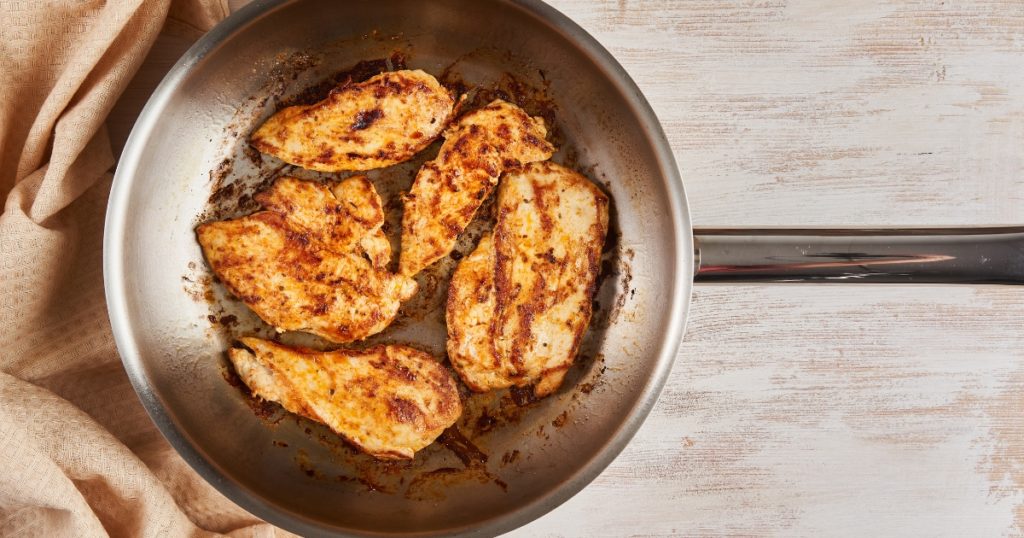
Fried chicken is the ultimate go-to for us busy moms. In fact, because it’s pretty fast and convenient to make, it’s a lifesaver!
Think about it; you can:
- Marinate chicken pieces with simple pantry staples like soy sauce, calamansi, and a bit of garlic, then use a pan or airfryer to achieve crispiness in an hour or less; or
- Get some already breaded chicken from the grocery, pop it in the oven toaster, wait, and eat fried chicken!
In short, fried chicken is always there to save the day, especially on those lunches or dinners when you can’t really think of what to cook.
Reason 2: Fried Chicken Is Easy To Access
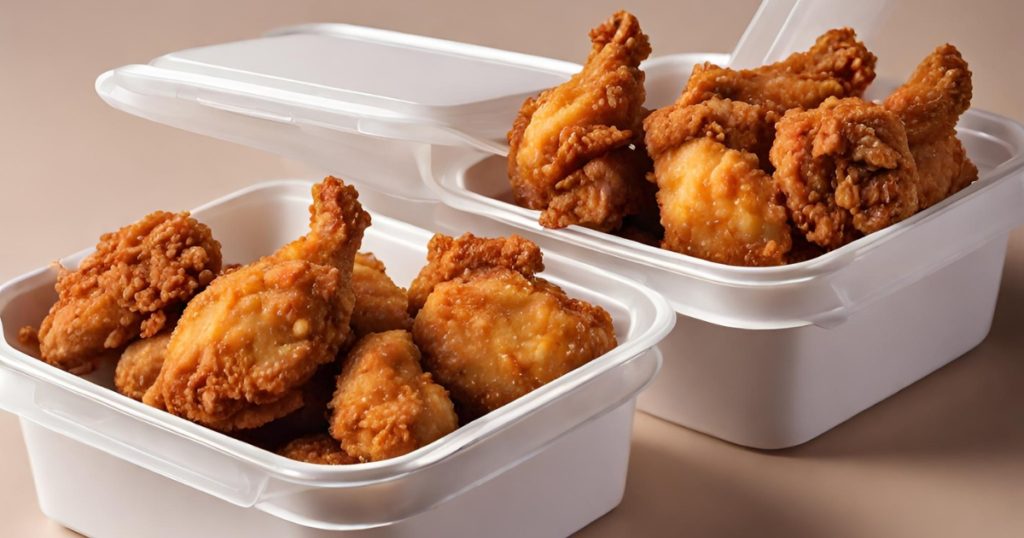
Fried chicken is practically everywhere here in the Philippines. Even street vendors have their own version. There’s just something about the taste of this deep fried goodness, I guess.
And that’s the great thing: it’s so common, you can get it anytime, anywhere, whether you’re at home and not wanting to cook, or on the road, and you’re looking for some delicious food. Admit it: you already have favorite fried chicken spots, such as one that has a secret mix of herbs and spices which makes it finger lickin’ good!
Reason 3: Practically Everyone Loves Fried Chicken

Who can resist fried chicken? No one, that’s for sure! Even the pickiest of eaters can’t resist this particular fried food. It’s the one dish that will bring smiles to everyone at the table.
Reason 4: Science Backs Me Up!

Did you know that even science explains why fried chicken tastes are irresistible? It’s all about the chemistry of fried food, also known as the Maillard reaction. It gives fried chicken the tempting golden color and mouth-watering flavor. This reaction creates a variety of flavor compounds, making each bite a complex taste experience.
But there’s more: the texture! The contrast between the crunchy outside and the juicy inside is scientifically proven to delight our taste buds. Studies show that this texture contrast not only pleases our palate but also makes us crave more. So, when we’re enjoying that crispy, juicy chicken, we’re actually delighting in a culinary marvel of science—cool, huh?
Reason 5: Fried Chicken Is Comfort Food

There’s an undeniable comfort in a good piece of fried chicken—there’s warmth and satisfaction that comes with every bite. The symbolism of fried chicken is a taste of home, no matter where you are.
And if you think about it, fried chicken is so delicious, but there’s more! Each crunchy bite reminds us of festive family celebrations, lazy Sunday lunches, and those impromptu gatherings that turn into cherished memories. It’s more than just food; it’s a comforting embrace, a reminder of happy times, and a simple pleasure that connects us to our loved ones and our roots.
Reason 6: It Goes With Everything
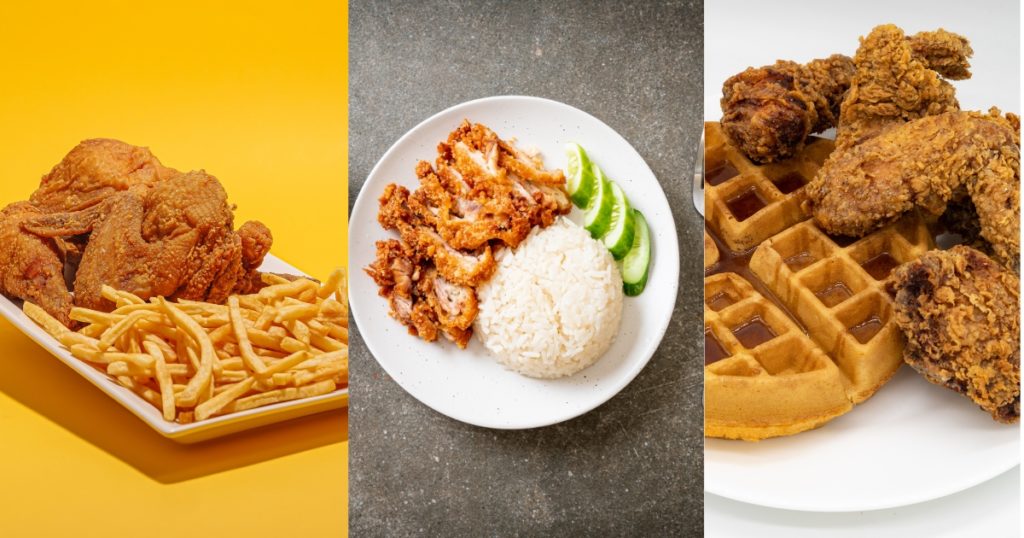
One of the best things about fried chicken is its incredible versatility. Whether it’s paired with rice, crispy fries, waffles, or if you want to use it as the meat for your sandwich, chicken just simply goes with everything!
Fried chicken also even fits into all kinds of meal settings. It’s a hit at a fancy dinner party, just as much as it is during a summer barbecue. No matter the occasion or the time of day, fried chicken is always welcome to the table.
Reason 7: Fried Chicken Is Very Versatile
Why do I love fried chicken? One more reason is it’s because it’s very versatile! You can enjoy the classic chicken taste, or go spicy, sweet, sour, and more. It’s always fun to play around and create your version of this beloved dish.
Let’s not forget the endless possibilities of flavors and marinades. You can go from a simple garlic and soy sauce marinade to a more adventurous coconut milk and lemongrass blend. The possibilities are endless!
Final Thoughts
So there you have it, my fellow Filipino moms! Fried chicken is more than just a dish; it’s a part of our culture, a comforting presence in our lives, and a reason to come together and celebrate. Here’s to more crispy, juicy, delightful moments – one piece at a time!
Love fried chicken? You’ll love this class!
As passionate about fried chicken as I am? Want to experience delicious fried chicken with those commercial tastes you love? Want to take your food business to the next level?
Well, you can do all that with the latest class here at The Bailiwick Academy by Chef Anthony Ang: Fry ‘Em Up: Pinoy Style-Fried Chicken!
This isn’t just any cooking class. It’s a golden opportunity to recreate the iconic flavors of famous Filipino fast-food fried chicken. Imagine mastering the art of making Whole Fried Chicken, Classic Chinese-style fried Chicken, and the crowd-pleaser, Famous Fast Food Fried Chicken—all of them tasting like some of those commercial chickens you love, or even better!
There’s a bonus too! You’ll learn the secret behind making super delicious garlic fried rice that pairs perfectly with these crispy delights.
Whether you’re a home cook looking to wow your family or an aspiring entrepreneur ready to cater to your clients’ discerning tastes, this class might be the one you’re looking for. Don’t miss out on this finger-licking opportunity—sign up at The Bailiwick Academy today and enroll in this class to elevate your fried chicken game!
—
Keep coming back to The Bailiwick Academy blog for more baking and cooking tips, kitchen tricks, and much more!
]]>What’s Cake Fiesta Manila 2023 all about?
Cake Fiesta Manila is not just any cake show. It’s the FIRST in the Philippines and the BIGGEST International Cake Show in Asia! With numerous global cake shows happening all over, the founders and organizers Valeri & Christina of Queen of Hearts Couture Cakes and Penk Ching of Pastry Bin wanted to establish one in the Philippines, which they started in 2019.
Cake Fiesta Manila’s mission is to uplift the standards of cake decorating in Asia by collaborating with top-tier suppliers and inviting the best instructors globally. The cake competitions are designed to spotlight and challenge the emerging talents in the cake world.
Cake Fiest Manila 2023 Happenings
This year promises even more excitement with the following:
Competitions: Open to everyone, from beginners to pros. Showcase your cake-decorating prowess and aim for that coveted GOLD medal!
Workshops: Learn from the BEST local and international cake artists. These hands-on workshops are a golden opportunity to refine your skills. But be quick to sign up; slots fill up fast!
Demos: Choose from a plethora of cake decorating topics presented by the world’s leading Cake Artists. Each 45-minute demo is packed with invaluable insights, tips, and tricks.
Vendors: Discover the best brands in the cake and bake industry. Ready your wallets for exclusive deals, especially from international vendors, saving you those hefty shipping costs!
Teachers: From buttercream to fondant, chocolate to sugar flowers, and much more. The best teachers are lined up to impart their knowledge.
Cake Wars: Witness the ULTIMATE Cake Decorating battle! Teams, including individuals, cake groups, schools, and even kids, will compete LIVE for the title and trophy.
Bake Bazaar: There will be a dedicated section for talented bakers to display and sell their delectable creations. Perfect for indulging or gifting!
Book Signings: Get your cake books autographed by renowned authors and snap a photo with them. Meet and Greet sessions with founders Valeri Valeriano and Christina Ong of Queen of Hearts Couture Cakes (also TBA instructors), co-founder Penk Ching, and other celebrated artists are on the cards.
Make and Take: Partnered with Maya, this feature allows attendees to craft under the guidance of talented teachers. Not only do you take home new skills, but also the treats you craft!
The Bailiwick Academy’s Role in Cake Fiesta Manila 2023
Cake Fiesta Manila 2022 was a fun one for me, the TBA team, and the Bailiwickers who attended. Check out these posts!



As you can see, not only did they get to participate in some of activities at Cake Fiesta Manila, they also got to meet some of their beloved chef instructors like Chef Bam Piencenaves, Chef Max Nadin, Chef Allan Mertola, Chef Chona Garcia Laureta, Chef Ely Salar, Sir Amir Valdez, Chef Marc Kevin Reyes, Sir Rodney Martinez, and Sir Joey Montanez!
Last year, we also organized a big meet and greet for Bailiwickers at our booth. That helped me meet a lot of Bailiwickers for the first time—something I really appreciated!
That’s not all—last year, I offered prizes to people who would visit our booth. For people who signed up, they got Php500 and Php250 vouchers for classes, while existing students got a 25% if they enrolled in a class in our booth. Everyone who dropped by also got the chance to win a special prize by playing a mini-game or by posting on social media.
We also had chefs doing demos in our booth back in 2019 and in 2022.
What do we have in store for people who visit booth E04 this year? Well, just wait and see! Sign up at The Bailiwick Academy to join our email list and get the latest updates.
Also, make sure you’re part of the TBA Student Lounge and that you’re following us on Facebook and be ready for our announcement of activities. I promise you won’t be disappointed!
How can you join Cake Fiesta Manila 2023?
Securing your spot is a breeze. Grab your tickets online for Cake Fiesta Manila 2023. Multiple ticketing options cater to everyone, whether you’re planning to attend a single day or immerse yourself in all the days..
VIP Ticket
If you want a special experience, grab the VIP ticket for Php2500. This includes access for all event days, fast track entries, front row seats, access to the VIP Lounge with complimentary refreshments, plenty of freebies, exclusive VIP goodies, and much more.
However, tickets are limited to only 100 buyers, so make sure you buy before you run out of tickets!
Regular Admission
You also have the option for regular tickets for only Php200 a day. For more details about the inclusions, just email the Cake Fiesta Manila team at [email protected].
Wrapping It Up
Again, I hope to see you at booth E04 at Cake Fiesta Manila 2023. We’ll be there from November 16-19, 2023 at the SMX Convention Center in Pasay City. Remember: Function Rooms 3 and 4 is the place to be!
And don’t forget: wait for our email or the announcements on our social media pages to find out what we have in store for you when you attend!
I’m eager to meet you, whether once again or for the first time. Get your tickets now and see you then!
—
Keep coming back to The Bailiwick Academy blog for more baking and cooking tips, kitchen tricks, and much more!
]]>Well, I can totally relate! I can’t count the number of times I’ve had customers call me, disappointed about how their ordered baked goods arrived. It’s definitely not a pleasant experience, just like how one Bailiwicker showed in the TBA Student Lounge.
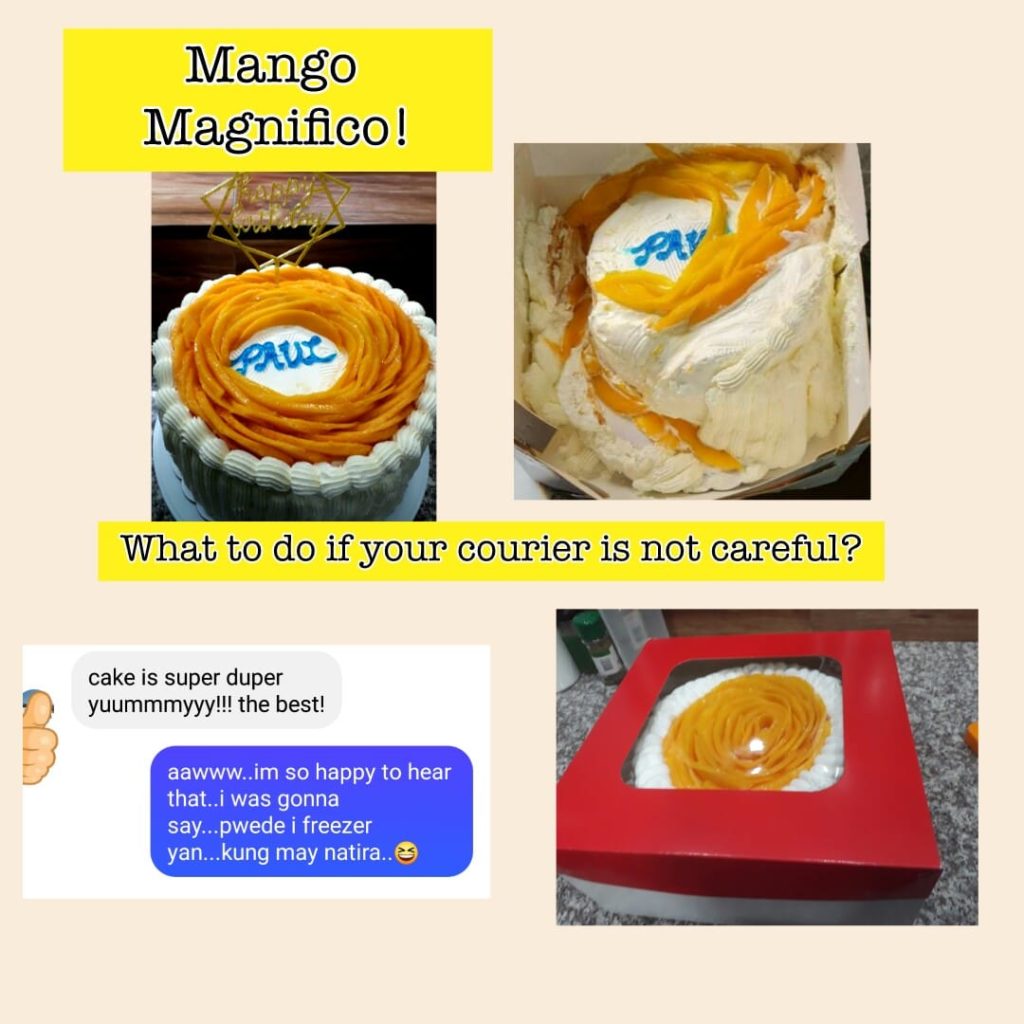
She ended up having to create another cake just to make the customer happy—at her expense, even if it wasn’t her fault. This is what we all want to avoid, agree?
If you’re looking for solutions on how to transport baked goods without them arriving disassembled in disarray, especially during this holiday season, keep reading. I’ll talk about tips for transporting desserts.
Ready to start? Let’s get to it!
*Note: This was originally written last December 12, 2020. It has been updated today, October 3, 2023.
How To Transport Your Baked Goods Safely: Things To Remember
For your baked goods, reaching their destination securely and intact means you’ll have to ensure the following:
Pick the Right Boxes or Containers
Whether you’re transporting banana bread or bundt cakes, picking the right treat box or container is very important. Use strong boxes or containers that are made for carrying food. This stops the food from moving around and ensures food safety.
Also, use wax or parchment paper to stop food from sticking and soft materials like bubble wrap to protect the fragile ones.
One more tip: don’t assume that a solution for one type of food will serve for other types. After all, how to transport freshly baked bread might differ from cakes with buttercream frosting, which likely require more care. Research what you should do to ensure transportation success.
If you’re looking for boxes, containers, wax papers, etc., check out the TBA Shop!
Consider Delivery Times
If your customer ordered something that, say, required you to do plenty of cake decorating, you want to make sure they get the order as soon as possible to prevent any damage that might happen. Therefore, especially in the Philippines, it’s probably best to have it delivered when it’s not traffic. That way, your cake will be in your client’s hands quicker—and you’ll have less stress to think about!
The temperature is also important when it comes to delivery times. For instance, some foods like chocolate can melt, and foods with cream can go bad if they get too warm. Again, that means the food should arrive at your client’s location as quickly as possible, which means delivering it at unusual hours if possible.
However, if it’s not, don’t forget to provide bags or coolers that can keep the food cool and, if needed, use ice packs to keep everything at the right temperature while the item is being delivered.
Place Foods Carefully in the Box or Container
When you transport desserts, keep in mind that how you place the food is important. Put the heavier ones at the bottom and the lighter, fragile ones on top. Don’t put too much in one box; leave space between foods so they don’t touch and ruin each other.
When you’re done packing, make sure your treat boxes or storage containers are closed tightly so nothing spills or gets dirty. Secure them with straps, mats, or even plastic wrap to keep everything in place.
That’s how to safely ship baked goods!
Take A Picture Of Your Item Before Having It Delivered
The best way to show to your client that you took extra care with transporting your baked goods is to take photos or even videos. That way, you have proof and a way to protect yourself in case you do run into a difficult client.
Do One Last Check
Before doing the final step of transporting baked goods, check everything one more time. Ensure all the food is packed tightly and you have the correct contact details. Let your customers know when you will arrive as well so they can be ready to get their orders.
How To Transport Your Baked Goods Safely: Have Customers Pick Up Their Order
Honestly, based on experience, getting your customer to come over and pick up their order is the best way for transporting baked goods. Why?
When customers pick up their orders, several potential problems are eliminated:
- Transit Damage: The risk of damaged or squished baked goods during delivery is removed. Customers can ensure that the products are handled to their own satisfaction during transport.
- Loss of Freshness: Without the potential delays of delivery routes, goods can be enjoyed at their freshest soon after they come out of the oven. Customers can also come with their own precautions when it comes to temperature-sensitive baked goods.
- Additional Costs: If customers pick up their orders, you’ll likely see fewer protests for delivery fees.
- Responsibility: Any potential mishaps during transportation, once the goods have been handed over, are no longer your responsibility. Just provide them with precautions and even the best roads to take on the way to you, and you don’t have to think about them afterwards.
So, encouraging customer pickups, when feasible, can be a win-win for both you and your customer in terms of product quality, cost, and overall experience. But what if your customer really can’t come over, and they’ll have to have your item delivered to them?
How To Transport Your Baked Goods Safely: Delivery Options
Thankfully, in the Philippines, there are plenty of ways for you to get your order to your clients. However, not all of them will ensure that your baked goods will arrive intact!
Let’s take a look at each one.
Bicycle
Getting your item delivered via bicycle means that your delivery fee will likely be cheaper. After all, a bike requires no fuel to run. Cyclists can also access paths or roads where cars will not necessarily fit, meaning there’s a possibility that your order will arrive sooner.
However, one thing to note is that bikes cannot necessarily go far. Bike deliveries are also affected by the weather. If it’s raining hard, bikers will likely stop and wait for the weather to improve.
Also, bikers can’t carry a lot. And because bikes can hit bumps, you need to pack your items really well so they don’t get damaged.
In short, if you want to make sure you don’t end up like this meme of Wadough’s:

Do not get bike deliveries for transporting cupcakes or other items that can be damaged due to movement.
Motorcycle
This delivery method is super popular—we’ve got many apps just for it. What’s good and bad about it?
Well, let’s look at the good first. Like bicycles, motorcycles can move quickly through traffic and tight spots, so deliveries arrive quicker. However, motorcycles or scooters can travel further than bikes.
Motorcycle deliveries are also affordable, making it great for small businesses. Plus, because it’s app-based, you can see where your delivery is.
Of course, motorcycles are not the sturdiest way to move things. They’re great if you’re thinking of how to transport freshly baked bread. But for delicate stuff like cakes (even if they’re in cake boxes) and pies, not so much.
Popular pie maker Hey Pie has even cautioned people from booking delivery of their orders via motorcycles:
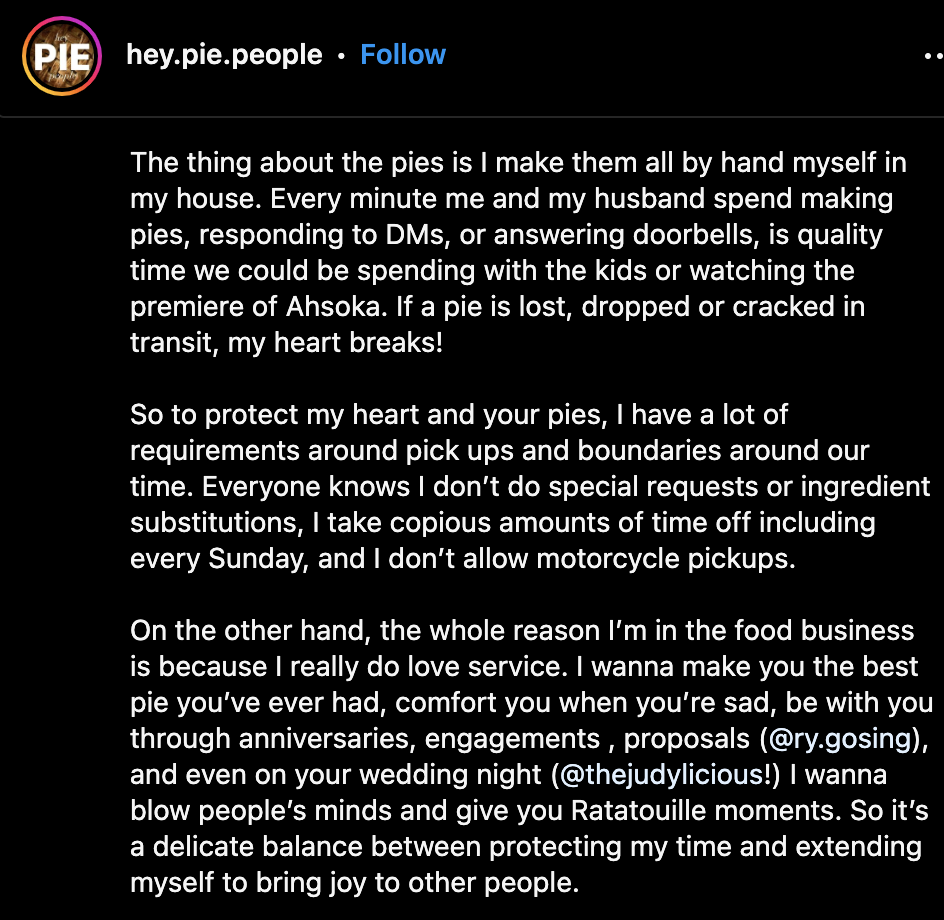
In short, if you’re going to go with a motorcycle, consider the nature of your baked goods and prioritize their safety. After all, a happy customer is one who receives their order in perfect shape.
Car
Using a car to transport your baked goods is a top choice. Cars can cover longer distances than bicycles or scooters, allowing you to deliver more substantial and numerous orders simultaneously. Weather, like mild or moderate rain, doesn’t affect car deliveries much, making it a reliable option in unpredictable conditions.
Plus, cars provide the sturdiest and safest method for fragile items like cakes in cake containers.
However, there’s a catch. Car deliveries are generally more expensive and can be slowed down by traffic, leading to potential delays. So, while it offers many benefits, it’s essential to consider the costs and potential time factors.
Which one should you book?
You have to decide: save money or make sure your goods arrive perfectly? Maybe spend more for better service?
It’s up to you. Everyone’s products and needs are different. Knowing what’s special about your baked goods will help you choose the best delivery way.
Conclusion
Considering how to transport your baked goods safely can be tricky, especially during busy months. You can use bikes, motorcycles, or cars, but each has its own good and bad sides. Sometimes, having your customer come and pick up their order is the best way.
No matter what you choose, always make sure your baked goods are packed safely. This will keep your customers happy and coming back for more. Good luck with all your deliveries this season!
And of course, for the best baked goods you can give to your clients, sign up at The Bailiwick Academy! See you in one of our classes!
—
Keep coming back to The Bailiwick Academy blog for more baking and cooking tips, kitchen tricks, and much more!
]]>